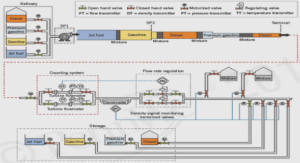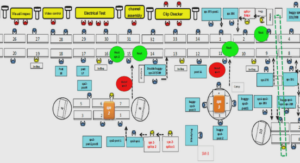Antimicrobial Activity of 23 Endemic Plants
INTRODUCTION
Madagascar is host to approximately 12,000 vegetable species, more than 80 % of which are endemic to the island [1]. Owing to environmental degradation, increasing deforestation, slash and burn agriculture in primary forest, this unique patrimony is threatened by extinction. Only 9 % of the original areas are currently available and the country is among 25 most critical regions for plant life protection in the world [2]. In Madagascar, herbal medicines are often used as the first line of treatment of various diseases. The practice of traditional medicine is well-embedded in the lifestyle of the eighteen indigenous tribes of Madagascar. Previous investigations on Madagascan flora mainly dealt with ethnobotanical practices of plants in folk medicine [3-5]. Screening surveys have already shown some biological activities such as antiplasmodial [6], antiviral [7], and cytotoxic activities [8]. However, very few scientific studies have been carried out on the putative antimicrobial properties of endemic plants in the island although many of them have been claimed by local traditional healers to be effective in the treatment of infectious diseases. The aim of this study was to investigate the antimicrobial properties of 23 endemic plants obtained from different parts of the country and to identify the phytochemical class of active components. EXPERIMENTAL Plant materials The plants were collected from various locations in Madagascar and were authenticated by Dr Armand Rakotozafy, the curator of the Department of Botany at the Institut Malgache de Recherches Appliquées (IMRA), Antananarivo, Madagascar. Voucher specimens were deposited at the herbarium of the Parc Botanique et Zoologique de Tsimbazaza, Antananarivo, Madagascar. Plant names and their folkoric use are given in Table 1. Dried plant materials were ground into fine powders and preserved at the IMRA herbarium.
Preparation of plant extracts
Dried and powdered plants (10 g) were macerated with agitation in 50 ml methanol (MeOH) overnight at room temperature. After filtration, the solvent was eliminated by evaporation at reduced pressure and crude extracts were dried at 45 °C using a speedvac concentrator (Savant), and stored at the IMRA bank at 4 °C. Microorganisms The bacterial strains used for the investigation were Bacillus subtilis, Staphylococcus aureus, Escherichia coli, Salmonella typhi and Pseudomonas aeruginosa, and were all obtained as clinical isolates from patients at the Microbiology Department, IMRA. The yeast strain, Candida albicans (MUCL 31360), was obtained from the Mycothèque de l’Université Catholique de Louvain (MUCL), Belgium. Stock cultures were maintained at 4 °C on slopes of nutrient agar (Difco) for bacteria and on Sabouraud dextrose agar (SDA, Difco) for the yeast, prior to their use. Determination of minimum inhibitory concentration (MIC) The broth microdilution method was used to assess the MIC of the different plant extracts in a 96-well microplate using a modified method [9]. Microbial suspensions were first prepared from an overnight culture of bacterial and fungal cells grown in flasks, each containing 10 ml of Mueller-Hinton Broth (Oxoid) for bacteria and Sabouraud dextrose broth (Difco) for yeast at 37 °C and 30 °C, respectively. The turbidity of the microbial suspensions was adjusted to 0.5 McFarland using Densicheck (BioMerieux). Stock solutions of the different extracts were prepared by re-suspending the crude methanol extracts in 10 % dimethyl sulfoxide (DMSO) to produce concentrations in the range of 1.25 – 160 mg/ml. These solutions were further diluted 10-fold with water and then sterilized by filtration through 0.22 µm membrane filters. A known volume (100 µl) of each solution was deposited in the wells. This was followed by the addition of 100 µl of the inoculum (approximately 106 CFU/ml for bacteria and 105 CFU/ml for C. albicans) was added to each well. The microplates were incubated overnight at 37 °C for bacteria and 30 °C for 48 h for C. albicans. After incubation, 40 µl of 0.2 mg/ml aqueous solution of methylthiazoyltetrazolium chloride (MTT) was added to each well and further incubated for 30 min at room temperature. MIC was defined as the lowest concentration in which no transformation of MTT was observed. Streptomycin sulfate and nystatin were used as positive controls and their MICs were determined using the same process. All samples were tested in triplicate and the tests were repeted twice
Bioautography agar-overlay assay with B. subtilis and C. albicans
Plant extracts showing significant antimicrobial activity with MICs values close to 1 mg/mL against B. subtilis or C. albicans were investigated by thin layer chromatography (TLC) bioautographic agar-overlay according to the method of Rahalison et al [10] with minor modifications. Twenty microlitres of different solutions of the methanol plant extract (400 µg) were applied to precoated Silica gel GF254 plates (Merck KGaA, Darmstadt, Germany). TLC plates were developed with ethyl acetate/methanol 1/1 (v/v) for B. subtilis and ethyl acetate/methanol/water 10/10/3 (v/v/v) for C. albicans and dried thoroughly overnight to achieve complete removal of the solvents. The developed TLC plates were thinly overlaid with molten malt extract agar and with SDA inoculated with an overnight culture of B. subtilis and C. albicans, respectively. The plates were incubated in a dark and humid chamber at 25 °C for 24 h for B. subtilis and 48 h for C. albicans. After incubation, cultures were sprayed with MTT and further incubated for 30 min at room temperature. Microbial growth inhibition appeared as clear zones around active Rakotoniriana et al Trop J Pharm Res, April 2010; 9 (2): 168 compounds against a purple background. The plates were in duplicate. One set was used for bioautography experiment and the other was intended for the reference chromatogram. The experiments were repeated twice.





